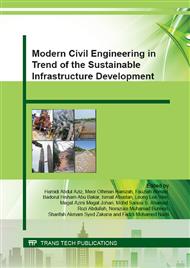[1]
P. L. Williams and C. Webb, The Delphi technique: a methodological discussion, Journal of advanced nursing, 19 (1994) pp.180-186.
DOI: 10.1111/j.1365-2648.1994.tb01066.x
Google Scholar
[2]
T. Sumsion, The Delphi technique: an adaptive research tool, The British Journal of Occupational Therapy, 61 (1998) pp.153-156.
DOI: 10.1177/030802269806100403
Google Scholar
[3]
F. Hasson, S. Keeney, and H. McKenna, Research guidelines for the Delphi survey technique, Journal of advanced nursing, 32 (2000) pp.1008-1015.
DOI: 10.1046/j.1365-2648.2000.t01-1-01567.x
Google Scholar
[4]
C. Powell, The Delphi technique: myths and realities, Journal of advanced nursing, 41 (2003) pp.376-382.
DOI: 10.1046/j.1365-2648.2003.02537.x
Google Scholar
[5]
H. A. Linstone and M. Turoff, The Delphi method: Techniques and applications 29: Addison-Wesley Reading, MA, (1975).
Google Scholar
[6]
M. R. Hallowell and J. A. Gambatese, Qualitative research: Application of the Delphi method to CEM research, Journal of construction engineering and management, 136 (2009) pp.99-107.
DOI: 10.1061/(asce)co.1943-7862.0000137
Google Scholar
[7]
H. P. McKenna, The Delphi technique: a worthwhile research approach for nursing?, Journal of advanced nursing, 19 (1994) pp.1221-1225.
DOI: 10.1111/j.1365-2648.1994.tb01207.x
Google Scholar
[8]
S. Keeney, F. Hasson, and H. P. McKenna, A critical review of the Delphi technique as a research methodology for nursing, International journal of nursing studies, 38 (2001) pp.195-200.
DOI: 10.1016/s0020-7489(00)00044-4
Google Scholar
[9]
E. F. Capdevila, www. scopus. com, Piel, 26 (2015) pp.1-2.
Google Scholar
[10]
N. Dalkey and O. Helmer, An experimental application of the Delphi method to the use of experts, Management science, 9 (1963) pp.458-467.
DOI: 10.1287/mnsc.9.3.458
Google Scholar
[11]
N. Reid, The Delphi technique: its contribution to the evaluation of professional practice, Professional competence and quality assurance in the caring professions, (1988) pp.230-262.
Google Scholar
[12]
M. Turoff, The design of a policy Delphi, Technological forecasting and social change, 2 (1970) pp.149-171.
DOI: 10.1016/0040-1625(70)90161-7
Google Scholar
[13]
H. A. Linstone, The delphi technique, in Environmental Impact Assessment, Technology Assessment, and Risk Analysis, ed: Springer, 1985 pp.621-649.
DOI: 10.1007/978-3-642-70634-9_22
Google Scholar
[14]
R. Beretta, A critical review of the Delphi technique, Nurse Researcher, 3 (1996) pp.79-89.
Google Scholar
[15]
J. Cantrill, B. Sibbald, and S. Buetow, The Delphi and nominal group techniques in health services research, International Journal of Pharmacy Practice, 4 (1996) pp.67-74.
DOI: 10.1111/j.2042-7174.1996.tb00844.x
Google Scholar
[16]
C. Okoli and S. D. Pawlowski, The Delphi method as a research tool: an example, design considerations and applications, Information & Management, 42 (2004) pp.15-29.
DOI: 10.1016/j.im.2003.11.002
Google Scholar
[17]
G. Rowe and G. Wright, Expert opinions in forecasting: the role of the Delphi technique, in Principles of forecasting, ed: Springer, 2001 pp.125-144.
DOI: 10.1007/978-0-306-47630-3_7
Google Scholar
[18]
A. Del Cano and M. P. de la Cruz, Integrated methodology for project risk management, Journal of Construction Engineering and Management, 128 (2002) pp.473-485.
DOI: 10.1061/(asce)0733-9364(2002)128:6(473)
Google Scholar
[19]
J. F. Yeung, A. P. Chan, and D. W. Chan, Developing a performance index for relationship-based construction projects in Australia: Delphi study, Journal of Management in Engineering, 25 (2009) pp.59-68.
DOI: 10.1061/(asce)0742-597x(2009)25:2(59)
Google Scholar
[20]
A. R. Afshari and R. M. Yusuff, Developing a Structural Method for Eliciting Criteria in Project Manager Selection, International Conference on Industrial Engineering & Operations Management Istanbul, Turkey, (2012).
Google Scholar
[21]
B. Xia and A. P. Chan, Measuring complexity for building projects: a Delphi study, Engineering, Construction and Architectural Management, 19 (2012) pp.7-24.
DOI: 10.1108/09699981211192544
Google Scholar
[22]
A. Majid, M. Zaimi, M. Baba, M. Mohamed, and A. Hakim, Knowledge management (KM) framework for the Malaysian construction consultant companies, (2006).
Google Scholar
[23]
H. Adnan and R. Morledge, Application of Delphi method on critical success factors in joint venture projects in the Malaysian construction industry, in 1st Scottish Conference for Postgraduate Researchers of the Built and Natural Environment, 2003 pp.41-49.
Google Scholar
[24]
A. Ceric, Minimizing communication risk in construction: a Delphi study of the key role of project managers, Journal of Civil Engineering and Management, 20 (2014) pp.829-838.
DOI: 10.3846/13923730.2013.802739
Google Scholar
[25]
D. W. Chan and J. H. Chan, Developing a performance measurement index (PMI) for target cost contracts in construction: a Delphi study, Construction law journal, (2012).
Google Scholar
[26]
M. Mozaffari, S. Fazli, and A. Sedaghat-Seresht, Identifying the most critical project complexity factors using Delphi method: the Iranian construction industry, Management Science Letters,. 2 (2012) pp.2945-2952.
DOI: 10.5267/j.msl.2012.09.014
Google Scholar
[27]
M. Mathonsi and W. Thwala, Factors influencing the selection of procurement systems in the South African construction industry, (2012).
Google Scholar
[28]
M. R. Hallowell, Techniques to minimize bias when using the Delphi method to quantify construction safety and health risks, in Building a Sustainable Future-Proceedings of the 2009 Construction Research Congress, (2009).
DOI: 10.1061/41020(339)151
Google Scholar
[29]
M. Fabiani and E. Donchin, Encoding processes and memory organization: a model of the von Restorff effect, Journal of Experimental Psychology: Learning, Memory, and Cognition, 21 (1995) p.224.
DOI: 10.1037/0278-7393.21.1.224
Google Scholar
[30]
R. Ono and D. J. Wedemeyer, Assessing the validity of the Delphi technique, Futures, 26 (1994) pp.289-304.
DOI: 10.1016/0016-3287(94)90016-7
Google Scholar
[31]
C. Hendrick and A. F. Costantini, Effects of varying trait inconsistency and response requirements on the primacy effect in impression formation, Journal of Personality and Social Psychology, 15 (1970) p.158.
DOI: 10.1037/h0029203
Google Scholar
[32]
C. -C. Hsu and B. A. Sandford, The Delphi technique: making sense of consensus, Practical assessment, research & evaluation, 12 (2007) pp.1-8.
Google Scholar


